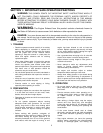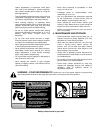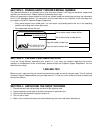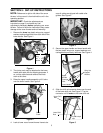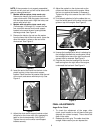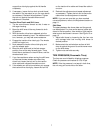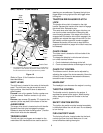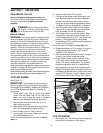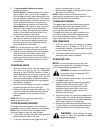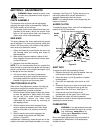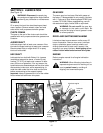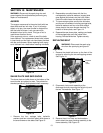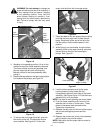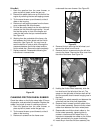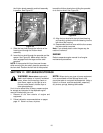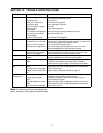
10
2. To avoid possible freeze-up of starter,
proceed as follows.
Electric Starter: Connect power cord to switch
box on engine, then to 120 volt AC receptacle.
With the engine running, push starter button and
spin the starter for several seconds. The unusual
sound made by spinning the starter will not harm
engine or starter. Disconnect the power cord
from receptacle first, and then from switch box.
Recoil Starter: With engine running, pull starter
rope with a rapid, continuous full arm stroke
three or four times. Pulling the starter rope will
produce a loud clattering sound, which is not
harmful to the engine or the starter.
3. To stop engine, push the throttle lever all the
way down, or remove the ignition key. Do not
turn key. Disconnect the spark plug wire from
the spark plug to prevent accidental starting
while equipment is unattended.
NOTE: Do not lose ignition key. Keep it in a safe
place. Engine will not start without the ignition key.
4. Wipe all snow and moisture from the carburetor
cover in the area of the control levers. Also,
move control levers back and forth several
times. Leave throttle control lever in the STOP or
OFF position. Leave choke control in the FULL
choke position.
TO ENGAGE DRIVE
1. With the engine running near top speed, move
shift lever into one of the six FORWARD
positions or two REVERSE positions. Select a
speed appropriate for the snow conditions that
exist. Use the slower speeds until you are
familiar with the operation of the snow thrower.
2. Squeeze the left hand auger clutch grip against
the handle to engage it.
3. While the left hand auger clutch grip is engaged,
squeeze the right hand drive clutch grip.
4. Release the left hand auger clutch grip only. The
interlock mechanism should keep the left hand
clutch engaged until the right hand clutch is
released.
NOTE: NEVER move shift lever without first
releasing the drive clutch.
TO STEER SNOWTHROWER
The trigger levers are located on the underside of
the handles and are used to steer your snowthrower.
NOTE: The drive clutch must be engaged when
using the triggers to steer the snow thrower.
1. To turn right, squeeze the right trigger lever and
guide the snowthrower to the right.
2. To turn left, squeeze the left trigger lever and
guide the snowthrower to the left.
3. Squeeze both triggers to transport the unit when
the engine is not running.
NOTE: These controls should be used while
operating your snowthrower in open areas until you
become familiar with their operation.
TO ENGAGE AUGERS
To engage augers and start snow throwing action,
squeeze the auger clutch grip against the left
handle. Release to stop the augers (traction drive
clutch grip must also be released).
The auger drive clutch can also be locked so you
can turn the chute crank without interrupting the
snow throwing process. Refer to “Traction Drive/
Auger Clutch Lock” in the Control section.
TIRE PRESSURE
1. Tires are over-inflated for shipping purposes.
Reduce the tire pressure to 10-15 p.s.i. for
snowthrower operation. Use pneumatic tires only
on your snowthrower unit.
2. Tire chains (optional equipment) should be used
whenever extra traction is needed.
OPERATING TIPS
NOTE:
Allow the engine to warm up for a few
minutes as the engine will not develop full power
until it reaches operating temperature.
WARNING
: Temperature of muffler and
surrounding areas may exceed 150
o
F.
Avoid these areas.
1. For most efficient snow removal, remove snow
immediately after it falls.
2. Discharge snow downwind whenever possible.
Slightly overlap each previous swath. The
distance that snow is being thrown can be
adjusted by altering the angle of the chute
assembly. Sharper the angle, shorter the
distance snow is thrown.
3. Set the skid shoes 1/4" below the scraper bar for
normal usage. The skid shoes may be adjusted
upward for hard-packed snow. Adjust downward
when using on gravel or crushed rock.
4. Be certain to follow the precautions listed under
‘‘To Stop Engine’’ to prevent possible freeze-up.
5. Clean the snow thrower thoroughly after each
use.
WARNING: Never attempt to clean
chute or make any adjustments while
engine is running.



